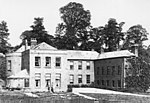Plymstock School
Plymstock School is a state comprehensive secondary school (ages 11–19) in Plymstock, a suburb of Plymouth, Devon, England. It was the first West Devon comprehensive school (built on the core of a post war secondary school) and is now a Specialist Sports College. As of January 2011 it has 1,626 students, of whom 240 are in the sixth form. In April 2011, the school became an academy. Plymstock School was maintained by Devon County Council until 1 April 1967, when it was transferred to Plymouth City Council which has maintained it until April 2011. In 2003 it underwent what was reported as a budget crisis, forcing redundancies and reduced spending on new classrooms to replace temporary facilities. Many of the latest school ratings, in local and national newspapers, have placed Plymstock in the top 5 of Plymouth schools, with the higher ranked schools being selective or fee-paying schools, and within the top 800 of England. (Herald, The Independent). As of the 2009, OFSTED report, this school has been rated as 'OUTSTANDING. Plymstock's local feeder primary schools include: Elburton Primary; Hooe Primary; Dunstone Primary; Pomphlett Primary; and Oreston Primary.
Excerpt from the Wikipedia article Plymstock School (License: CC BY-SA 3.0, Authors).Plymstock School
Church Road, Plymouth Plymstock
Geographical coordinates (GPS) Address Phone number Website External links Nearby Places Show on map
Geographical coordinates (GPS)
| Latitude | Longitude |
|---|---|
| N 50.36218 ° | E -4.08796 ° |
Address
Plymstock School
Church Road 29
PL9 9AZ Plymouth, Plymstock
England, United Kingdom
Open on Google Maps





